Commercial and recreational blue crab fishers in South Carolina (SC) are taking in their stride new conservation rules limiting daily catches from fisheries.
The Department of Natural Resources (DNR) implemented the rules on July 1, 2025, a year after passing the law.
This follows a 2021 report that recorded the lowest blue crab stock in SC in half-a-century, especially peeler crabs (juveniles).
In contrast, peeler crab harvests are legal in nearby Virginia, albeit in limited catches concurrent with those of hard crabs.
Lowest Limits in 8 Decades
In a first in over 80 years, SC’s commercial crabbers can now only haul in 2 bushels of the crustacean per vessel.
Besides, a 2024 mandate puts licenses of commercial fishers at risk if they don’t land a certain volume of crabs annually.
Regarding which, some crabbers are behind the conservation rules but are circumspect about the need to reach unspecified yearly landings.
One such is crabber Harry Wertan, who has lost his license for not meeting his total catch requirement. He told ABC News4 that the authorities are imposing population conservation rules and yet want fishers to meet certain totals.
Also in the rulebook are individual fishers whose daily limits are 1 bushel, with all crabs measuring over 5 inches long.
Crabbers who employ crab pots or traps also need to fix them with rings to allow peeler crabs to escape. Hitherto, crab pots and traps with rings have been only applicable to commercial fishermen.
Recreational fishers will have to pay an additional $5 to catch a maximum 5 bushels a day for non-commercial uses.
Beforehand, the maximum limited period sporting crabbers could catch with no additional charge was two bushels daily.
In comparison, commercial fishermen in nearby Maryland currently enjoy blue crab prices in the $100-$250-per-bushel range.
Stock Status from a Fisherman’s Eyes
Despite blue crabbing earning the state $6 million a year, rapid population declines have occasioned conservation concerns, which fishermen themselves share.
One of those backing conservation is Roger Williams, a fishing veteran on the saltwater coast of the Low Country.
“I [used to] come out here and catch 20 bushels of crabs,” Williams recites of glory days to WBTW News on July 3, 2025. Now, even without catch limits, the highest he can manage to land are five bushels a day.
He and his son further recommend stringent conservation laws to rejuvenate reproductive females and young crabs.
And so, will the newest rules recover the blue crab heights that SC’s fisheries used to know in the early 2000s? Below statistics offer a look at the contrast between today’s and past landings of this popular stew-making seafood.
SC Blue Crab Fisheries Statistics
The Low Country of marshy waters on the Atlantic Coast in southern South Carolina is a main source of blue crabs. According to the Department of Natural Resources (DNR), South Carolina’s blue crabs represent 10% of all seafood commercial landings, as of 2005. Since the mid-2000s, landings have however taken a hit due to population declines in the waters of the state. While in 2005 annual landings amounted to 4.32 million pounds, by 2023 the hauls had flattened to over $3.4 million pounds.
What were SC’s blue crab commercial landings in the 2019-23 period?
According to the National Oceanic and Atmospheric Administration (NOAA), South Carolina had its highest 2021-23 blue crab landings in 2019 at 3,971109 pounds. The table below illustrates the facts.
| Year | Landings |
| 2023 | 3,421,789 lb [1,552 t] |
| 2022 | 2,380,904 lb [1,080 t] |
| 2021 | 2,603,800 lb [1,181 t] |
| 2020 | 3,421,731 lb [1,552 t] |
| 2019 | 3,971,109 lb [1,801 t] |
Do blue crabs make a big economic contribution to South Carolina?
The blue crab sector in SC earns the state an average of 5 to $6 million annually (2024). This is about 10% of all state revenue from all fisheries and aquaculture. In the 2019-23 period, 2023 had the highest contribution at $6.55 million while 2021 followed with approximately $6.1 million. The lowest returns in the five-year period were in 2022 at over $4.9 million due to equally low landings at 1,080 tonnes.
